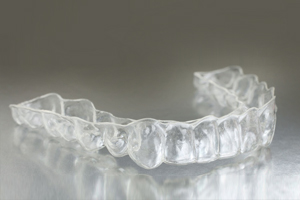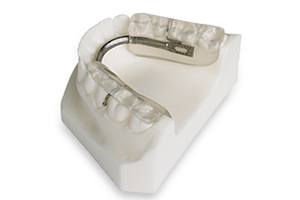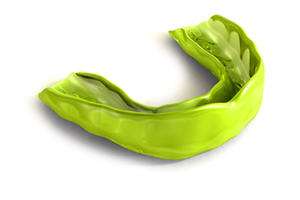
Hard Night Guards
Occlusal splints (also called bite splints or bite planes) are removable dental appliances carefully molded to fit the upper or lower arches of teeth. They are used to protect tooth and restoration surfaces, manage Temporomandibular Joint Dysfunction, and stabilize the jaw joints during occlusion or create space prior to restoration procedures. People prone to nocturnal bruxism or nighttime clenching, may routinely wear occlusal splints at night.
Occlusal splints are typically made of a heat-cured acrylic resin. Soft acrylic (see below for IMPAK or Therm-O-Flex Night Guards) or light cured composite, or vinyl splints may be made more quickly and cheaply, but are not as durable, and are more commonly made for short-term use. Soft splints are also used for children, because normal growth changes the fit of hard splints.
They generally cover all the teeth of the upper or lower arch, but partial coverage is sometimes used. Occlusal splints are usually used on either the upper or the lower teeth, termed maxillary splints or mandibular splints respectively, but sometimes both types are used at the same time. Maxillary splints are more common, although various situations favour mandibular splints and may incorporate clasps to retain the appliance in the mouth.
 Impak or (Therm-O-Flex) Night Guards:
Impak or (Therm-O-Flex) Night Guards:
Are very similar to Hard Night Guards, function and performing the same way, except for the fact that they are maliable under warm water, which allow easier insertion by the patient.

Gelb Appliances
Also known as Gelb splints, Gelb appliances are small TMJ appliances for the mandibular arch. The design of a Gelb appliance includes a wrought lingual bar; a posterior bite pad in each quadrant and ball clasps for retention; this helps reduce the bulk of the appliance making it more comfortable for the patient. The Gelb was designed to be a daytime appliance for patients’ requiring full-time wear for pain management.
 Sports Guards
Sports Guards
Are protective devices for the mouth that cover the teeth and gums to prevent and reduce injury to the teeth, arches, lips and gums. Depending on application, it may also be called a mouth protector, mouth piece, gumshield, gumguard, nightguard, occlusal splint, bite splint, or bite plane mouthguard, it is most often used to prevent injury in contact sports, as a treatment for bruxism or TMD (see above for Night Guards), or as part of certain dental procedures, such as tooth bleaching.
